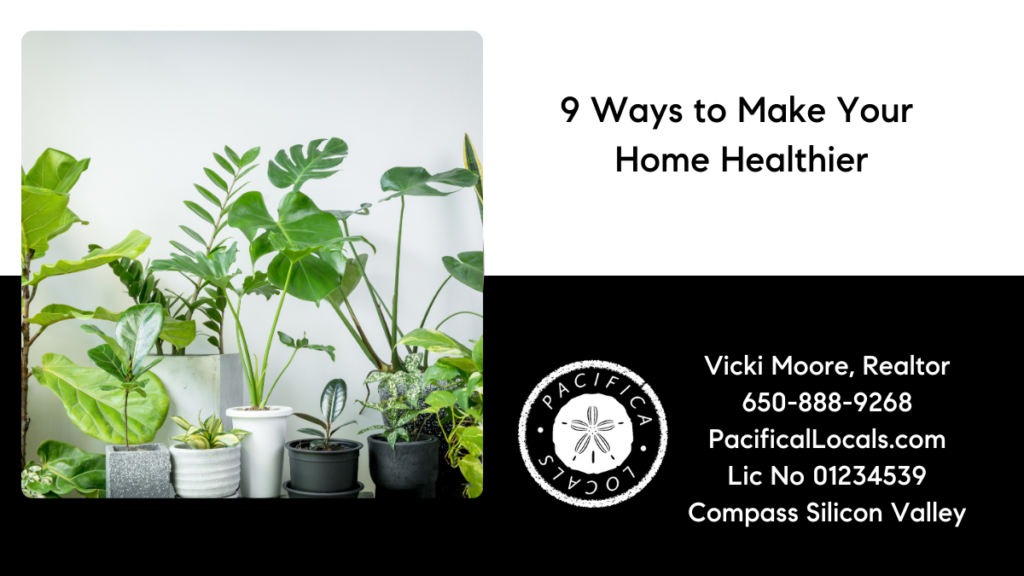Making your home healthier can just be a matter of a few changes. Your geographic region brings different considerations to your living style and the options for a healthier home. Take a look at our options for those of you living on the coast.
1. Ventilate Your Home
Ventilating your home is crucial for having a healthy indoor environment. Opening your windows is a simple and cost-effective method to introduce fresh air into your living spaces. Fresh air and air circulation help to decrease the concentration of indoor air pollutants.
Additionally, utilizing exhaust fans in bathrooms and kitchens can enhance ventilation, especially in bathrooms without windows. Allowing these fans to run for up to an hour expels stale air and brings in a flow of fresh air. It’s important to periodically check and clean the filters. This ensures optimal functioning and maintains the quality of the circulated air.
Turn on ceiling fans, open windows, and you’ll get quick results.
2. Avoid Artificial Air Fresheners
Opt for natural alternatives like essential oils instead of synthetic air fresheners. Synthetic air fresheners have infiltrated our homes. They come in sprays, candles, and plug-in options. They will make indoors spaces smell better. But they can also be highly toxic.
Phthalates are featured in perfumes and air fresheners. When used, phthalates are released into the air and can be inhaled or land on the skin, leading to absorption. Once these chemicals enter the bloodstream, they have the ability to disrupt hormone levels and contribute to various health issues.
Phthalates are particularly known for interfering with the production of the male hormone, testosterone, and have been linked to reproductive abnormalities. Animal studies have shown that prenatal exposure to certain phthalates can result in decreased testosterone, genital malformations, and reduced sperm production.
The State of California has identified five types of phthalates, including one found in air freshener products, as “known to cause birth defects or reproductive harm.” Exposure to phthalates in indoor environments has also been associated with allergic symptoms and asthma.
3. Eliminate Carpets
Carpets are often made with synthetic materials that can cause respiratory issues, eye irritation, and hormone disruption. Padding and glues have their own toxic ingredients that can create Formaldehyde when combined.
4. Use Natural Cleaning Products
Cleaning products can contain a variety of chemicals, and while many are safe when used as directed, some can pose health risks, especially with prolonged or improper exposure. Here are some common chemicals found in cleaning products and their potential health effects:
Volatile Organic Compounds (VOCs):
- Found in: Aerosol sprays, air fresheners, carpet cleaners, and some disinfectants.
- Health effects: Respiratory irritation, headaches, dizziness, and in some cases, long-term exposure may contribute to more severe health issues.
Phthalates:
- Found in: Fragranced products like air fresheners, dish soap, and personal care products.
- Health effects: Endocrine disruption, reproductive and developmental toxicity, and potential links to asthma and allergies.
Ammonia:
- Found in: Glass cleaners, bathroom cleaners, and some multi-surface cleaners.
- Health effects: Irritation of the eyes, skin, and respiratory system. Mixing ammonia with certain other cleaning agents can produce harmful fumes.
Bleach (Sodium Hypochlorite):
- Found in: Disinfectants, mold and mildew removers, and some laundry detergents.
- Health effects: Respiratory irritation, skin burns, and in extreme cases, exposure to high concentrations can lead to more severe health issues.
Triclosan:
- Found in: Antibacterial and antimicrobial products, such as hand soaps and dishwashing liquids.
- Health effects: Concerns about antibiotic resistance and potential disruption of hormone regulation.
Quaternary Ammonium Compounds (Quats):
- Found in: Disinfectants, fabric softeners, and some all-purpose cleaners.
- Health effects: Respiratory irritation, and some studies suggest potential links to asthma and other adverse respiratory effects.
Sodium Hydroxide (Lye):
- Found in: Oven cleaners, drain cleaners, and certain degreasers.
- Health effects: Severe skin and eye irritation, and inhalation can cause respiratory issues.
Petroleum-Based Solvents:
- Found in: Some spot removers, carpet cleaners, and degreasers.
- Health effects: Respiratory irritation, headaches, and long-term exposure may affect the nervous system.
It’s essential to read labels, use products as directed, and consider alternatives like natural or eco-friendly cleaning products. Proper ventilation and protective measures, such as wearing gloves and avoiding mixing different products, can also help minimize potential health risks.
5. Indoor Plants
Having plants in your home offers more than just aesthetic appeal. They contribute to a healthier living environment. Indoor plants play a crucial role in improving air quality by absorbing pollutants and releasing oxygen during photosynthesis. This natural process helps to create a cleaner and fresher atmosphere indoors.
Moreover, some plants have the ability to regulate humidity levels, making them particularly beneficial in maintaining a comfortable and healthy indoor climate. The presence of greenery not only enhances the overall well-being of a space but also promotes a sense of calm and connection to nature, fostering a positive and health-conscious atmosphere within your home.
Choose low-maintenance plants for easy care.
6. Control Humidity Levels
Using dehumidifiers is a practical way to maintain a healthy indoor environment by controlling moisture levels. Excess humidity can lead to the growth of mold and mildew, which not only damages your home but can also pose health risks.
Dehumidifiers help by extracting excess moisture from the air, creating an inhospitable environment for mold growth. By doing so, they contribute significantly to improving overall indoor air quality.
Controlling humidity not only safeguards against structural damage but also reduces the likelihood of respiratory problems associated with mold exposure. And is especially important in areas at and near the coast.
7. Choose Non-Toxic Furniture
If you’re planning to purchase some new furniture for your home, consider opting for pieces made from natural materials or those with low VOC (volatile organic compound) emissions.
Furniture constructed from natural materials such as wood, bamboo, or metal not only adds a touch of authenticity to your living space but also tends to have fewer harmful chemicals.
Additionally, choosing furniture with low VOC emissions is crucial for maintaining indoor air quality. VOCs released from certain furniture materials can contribute to indoor air pollution and may have adverse health effects.
8. Regularly Change HVAC Filters
Replace air filters in heating, ventilation, and air conditioning (HVAC) systems regularly to ensure clean air circulation.
9. Reduce Clutter
Regularly replacing air filters in heating, ventilation, and air conditioning (HVAC) systems is essential for ensuring clean air circulation within your home. These filters play a crucial role in trapping dust, allergens, and other airborne particles, preventing them from circulating through the air.
Over time, these filters can become clogged, reducing their effectiveness and allowing pollutants to infiltrate your living spaces. By being diligent in replacing these filters, you not only maintain the efficiency of your HVAC system but also enhance the overall air quality in your home. This simple yet impactful practice contributes to a healthier indoor environment, reducing the potential for respiratory issues and creating a more comfortable living space for you and your family.
Bottom Line
In conclusion, making your home a healthier place is achievable through a few straightforward changes. Start with small changes. It doesn’t have to all be done at once. Consideration of your geographic region is vital as it influences living style and health-conscious choices for a healthier home.
From ventilating your home to avoiding artificial air fresheners, eliminating carpets, and using natural cleaning products, each adjustment contributes to a safer and more pleasant living environment.
Incorporating indoor plants enhances air quality and fosters a connection to nature. Controlling humidity levels with dehumidifiers and choosing non-toxic furniture further supports a health-conscious lifestyle. Regularly changing HVAC filters and reducing clutter are additional practices that significantly contribute to clean air circulation. These holistic measures collectively create a healthier, more comfortable home for you and your family. Specific considerations for coastal living can further refine these efforts.

